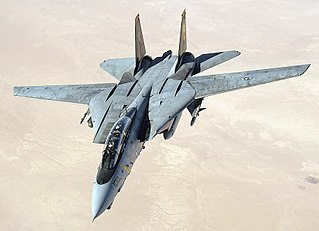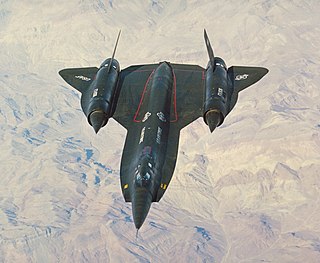The AIM-54 Phoenix is an American radar-guided, long-range air-to-air missile (AAM), carried in clusters of up to six missiles on the Grumman F-14 Tomcat, its only operational launch platform.

The Grumman F-14 Tomcat is an American carrier-capable supersonic, twin-engine, two-seat, twin-tail, variable-sweep wing fighter aircraft. The Tomcat was developed for the United States Navy's Naval Fighter Experimental (VFX) program after the collapse of the General Dynamics-Grumman F-111B project. A large and well-equipped fighter, the F-14 was the first of the American Teen Series fighters, which were designed incorporating air combat experience against MiG fighters during the Vietnam War.

The Lockheed YF-12 was an American Mach 3+ capable, high-altitude interceptor prototype, developed and manufactured by American aerospace company Lockheed Corporation.

The North American XF-108 Rapier was a proposed long-range, high-speed interceptor aircraft designed by North American Aviation intended to defend the United States from supersonic Soviet strategic bombers. The aircraft would have cruised at speeds around Mach 3 with an unrefueled combat radius over 1,000 nautical miles, and was equipped with radar and missiles offering engagement ranges up to 100 miles (160 km) against bomber-sized targets.

The Douglas F6D Missileer was a proposed carrier-based fleet defense fighter designed by Douglas Aircraft Company in response to a 1959 United States Navy requirement. It was designed to be able to loiter for extended periods at a relatively long distance from the Navy's aircraft carriers, engaging hostile aircraft 100 miles (160 km) away with its powerful radar and long-range missiles. Since the enemy would be fired on long before they reached visual range, the aircraft had little dogfighting capability and was strictly subsonic. When doubts were expressed about the Missileer's ability to defend itself after firing its missiles, the value of the project was questioned, leading to its cancellation. Some of the Missileer's systems, primarily the engines, radar, and missiles, continued development in spite of the cancellation, eventually emerging on the ill-fated General Dynamics–Grumman F-111B and successful Grumman F-14 Tomcat years later.

The Hughes AIM-47 Falcon, originally GAR-9, was a very long-range high-performance air-to-air missile that shared the basic design of the earlier AIM-4 Falcon. It was developed in 1958 along with the new Hughes AN/ASG-18 radar fire-control system intended to arm the Mach 3 XF-108 Rapier interceptor aircraft and, after that jet's cancellation, the YF-12A. It was never used operationally, but was a direct predecessor of the AIM-54 Phoenix used on the Grumman F-14 Tomcat.
A beyond-visual-range missile (BVR) is an air-to-air missile (BVRAAM) that is capable of engaging at ranges of 20 nmi (37 km) or beyond. This range has been achieved using dual pulse rocket motors or booster rocket motor and ramjet sustainer motor.

A pulse-Doppler radar is a radar system that determines the range to a target using pulse-timing techniques, and uses the Doppler effect of the returned signal to determine the target object's velocity. It combines the features of pulse radars and continuous-wave radars, which were formerly separate due to the complexity of the electronics.

The AN/MPQ-64 Sentinel is an X-band electronically steered pulse-Doppler 3D radar system used to alert and cue Short Range Air Defense (SHORAD) weapons to the locations of hostile targets approaching their front line forces. It is currently produced by Raytheon Missiles & Defense.

The AN/APG-63 and AN/APG-70 are a family of all-weather multimode radar systems designed by Hughes Aircraft for the F-15 Eagle air superiority fighter. These X band pulse-Doppler radar systems are designed for both air-air and air-ground missions; they are able to look up at high-flying targets and down at low-flying targets without being confused by ground clutter. The systems can detect and track aircraft and small high-speed targets at distances beyond visual range down to close range, and at altitudes down to treetop level. The radar feeds target information into the aircraft's central computer for effective weapons delivery. For close-in dogfights, the radar automatically acquires enemy aircraft and projects this information onto the cockpit head-up display. The name is assigned from the Army Navy Joint Electronics Type Designation System.
The AN/APG-65 and AN/APG-73 are designations for a family of all-weather multimode airborne radar systems designed by Hughes Aircraft for the F/A-18 Hornet, and used on a variety of fighter aircraft types. The APG-79 is an upgraded AESA version.
The Hughes AN/ASG-18 Fire Control System was a prototype airborne fire control radar system for the planned North American XF-108 Rapier interceptor aircraft, and the Lockheed YF-12 for the United States Air Force. It was the US's first Pulse-Doppler radar, giving it look-down/shoot-down capability, and was also the first track while scan radar. This was paired with an infrared search and track (IRST) system. Range of the radar was estimated at between 200 and 300 miles, with reliable detection of bomber-sized targets at 100 miles (160 km). The installation itself was massive, weighing 2,100 lb (953 kg), and taking up most of the nose of the aircraft. The system was to be used with the Hughes AIM-47 Falcon missile, which also had a range of about 100 miles.
A radar system has look-down/shoot-down capability if it can detect, track and guide a weapon to an air target that is silhouetted against the ground.
Radar Doppler Multitarget is a multimode Look-down/shoot-down Pulse-Doppler radar designed by Thomson-CSF for the Mirage 2000-5 fighter. The RDY-3 derivative has been fitted to Moroccan Mirage F1's. Thomson has claimed that the original RDY outperformed the AN/APG-66/68 of the F-16 and the AN/APG-65 of the F/A-18 Hornet.
The track while scan (TWS) is a mode of radar operation in which the radar allocates part of its power to tracking the target or targets while part of its power is allocated to scanning, unlike the straight tracking mode, when the radar directs all its power to tracking the acquired targets. In the TWS mode the radar has a possibility to acquire additional targets as well as providing an overall view of the airspace and helping maintain better situational awareness.
The AN/APG-67 is a multi-mode all-digital X band coherent pulse doppler radar originally developed by General Electric for the Northrop F-20 Tigershark program of the early 1980s. It offers a variety of air-to-air, air-to-ground, sea-search and mapping modes, and compatibility with most weapons used by the US Air Force in the 1980s.

The General Dynamics–Grumman F-111B is a long-range carrier-based interceptor aircraft planned as a follow-on to the F-4 Phantom II for the United States Navy (USN).
The RDM (Radar Doppler Multifunction), also known as the Cyrano 5, is a French multimode pulse-Doppler radar developed by Thomson-CSF (now Thales) for export variants and early French models of the Mirage 2000 fighter aircraft. It is an evolution of the Cyrano IV installed on the Mirage F-1 and in turn was developed into the RDI (Radar Doppler à Impulsions), a specialist air-to-air radar for French Mirage 2000 interceptors, and the multimode RDY (Radar Doppler Multitarget), which could track more targets at a time and added further air-to-ground modes.

The AN/APQ-120 was an aircraft fire control radar (FCR) manufactured by Westinghouse for the McDonnell Douglas F-4E Phantom II. AN/APQ-120 has a long line of lineage, with its origin traced all the way back to Aero-13 FCR developed by the same company in the early 1950s. A total of half a dozen FCRs were tested and evaluated on the first 18 F-4s built, but they were soon replaced by later radars produced in great numbers, including AN/APQ-120.











